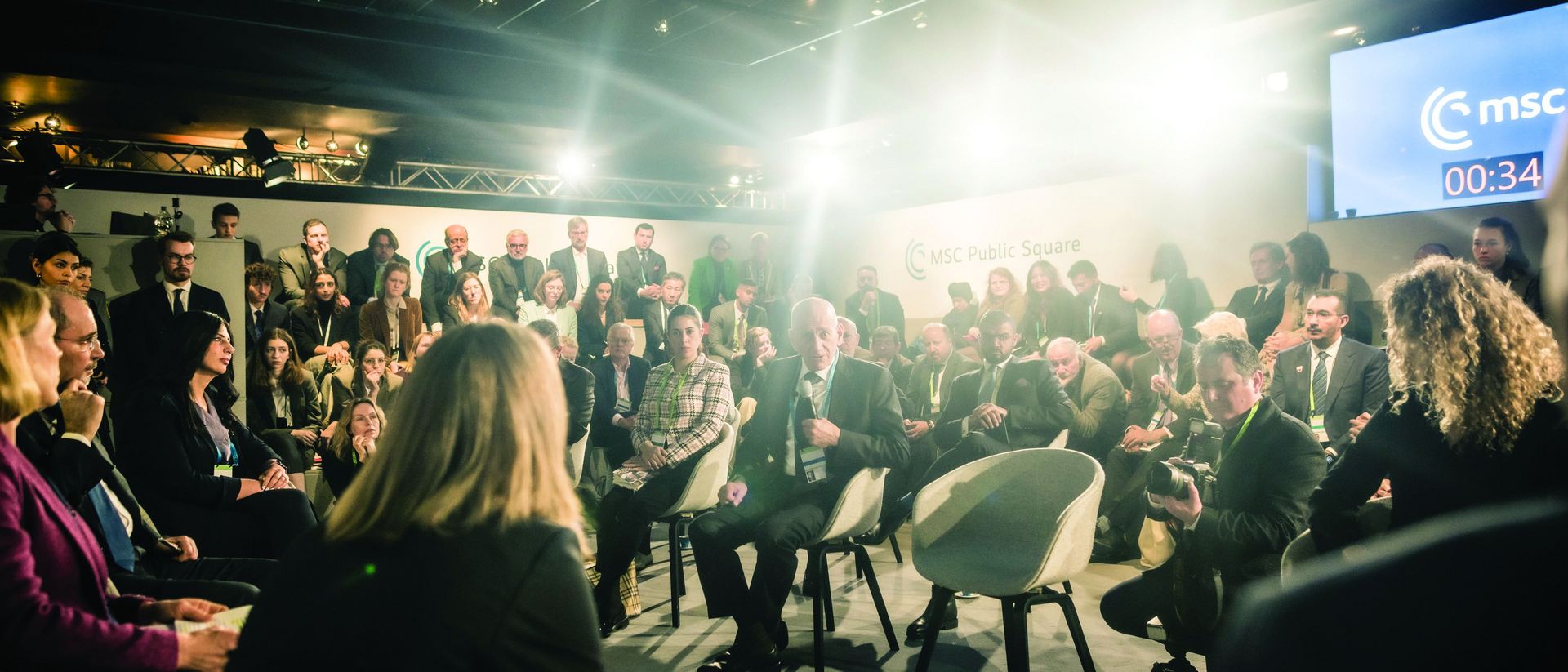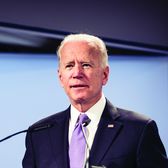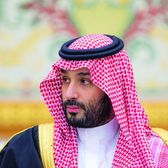

Abraham Discord
Middle East
 AuthorAmadée Mudie-Mantz
AuthorAmadée Mudie-Mantz AuthorSophie Witte
AuthorSophie Witte
 AuthorAmadée Mudie-Mantz
AuthorAmadée Mudie-Mantz AuthorSophie Witte
AuthorSophie Witte
Key Points
Prior to the outbreak of war between Hamas and Israel, remarkable rapprochements between erstwhile rivals had seemed to alter the geopolitical dynamics in the Middle East. Pragmatic cooperation across an array of new or revived frameworks produced mutual economic benefits and, on the surface, greater political stability.
Middle Eastern states capitalized on their position as a bridge between world regions. Refusing to align with any of the competing powers, they reaped the benefits of cooperating in various multilateral frameworks.
However, tensions continued to simmer. Surging military spending is a testament to persisting distrust and relative- gains mindsets. Iran’s pursuit of nuclear weapons and its proxy militias challenge both Israel and Saudi Arabia. Saudi Arabia is trying to contain Iran, while its relationship with the UAE is souring.
Above all, the Hamas terrorist attacks and the fallout from the ensuing war with Israel call regional rapprochement into question and threaten to spur a vicious cycle of broader regional violence.
The Middle East was experiencing a remarkable trend of rapprochement in recent years. The Abraham Accords stand out, as they enabled unprecedented warming of relations between Israel and four Arab states. These agreements seemed to be part of a pragmatic foreign policy shift, prioritizing deescalation and stability in the region, which attracted increased involvement of external powers. Middle Eastern leaders seized the opportunity by creating and joining several cooperation frameworks. They aimed to diversify relations in light of the perceived retreat of the US and reap the benefits of Chinese offers.[1] However, the terrorist attacks by Hamas against Israel on October 7, 2023, and the ensuing war shook the region, possibly rupturing this trend. In one day, the terrorist group killed over 1,200 people and abducted around 240 more. Israel’s ensuing military campaign to destroy Hamas, which uses civilians as human shields, has devastated infrastructure in Gaza and resulted in an estimated death toll of 22,000 Palestinians by early 2024.[2] The fear of regional conflagration looms large as Israel continues its military campaign in Gaza while Iranian proxies in Lebanon, Yemen, Syria, and Iraq intensify their attacks on Israeli and US troops. The war thus risks dashing the tentative hopes for rapprochement in the Middle East.
Fragile Cooperation
The pre-war wave of regional rapprochement marked a major foreign policy shift in the Middle East. The 2020 Abraham Accords constituted unprecedented normalization of relations between Bahrain, Morocco, Sudan, and the United Arab Emirates (UAE). Brokered by the US, the Accords aim to enable regional integration, while also forming part of a containment strategy against Iran.[3] The US additionally facilitated negotiations between Israel and Saudi Arabia, during which Riyadh demanded US support for a civilian nuclear program and binding US defense commitments.[4] Similar to other negotiations in the region, these talks sidelined the plight of the Palestinians. They were halted after the recent outbreak of war between Hamas and Israel.[5]
Saudi Arabia and Iran reached a milestone deal in March 2023, which reactivated diplomatic, economic, and security ties between the traditional rivals.[6] This deal was brokered by China, although experts argue that the Saudi government only allowed Beijing to finalize the deal to capture US attention.[7] Middle Eastern powers also revitalized existing regional cooperation frameworks. For example, the 2021 Al-Ula Declaration ended the Saudi-driven blockade against Qatar, which allowed for renewed ties between Qatar and the Gulf Cooperation Council (GCC), although it had not resolved the issues leading to its blockade.[8] Another example was the readmission of Syria into the Arab League in 2023, despite the ongoing civil war and the war crimes committed by Syrian President Bashar al-al-Assad's regime.[9]

[The India–Middle East–Europe Economic Corridor is] all about economic growth. That has nothing to do with hurting China or helping China. It has to do with dealing with everything from climate change to making sure that these countries can succeed economically and grow.
Joseph Biden•US President, September 10, G20 Summit, 2023
Middle Eastern countries' membership in selected cooperation frameworks
The Middle East was receiving increased attention from external powers, especially in the form of invitations to join transregional cooperation frameworks. In August 2023, BRICS members invited six states to join, including Egypt, Iran, Saudi Arabia, and the UAE. This expansion is largely seen as part of China’s strategy to increase its presence in the region, which it has further pursued by inviting several Middle Eastern countries to join the Shanghai Cooperation Organization.[10] Russia also maintains a presence in the region, particularly through close ties with Syria and Iran as well as OPEC.[11] However, the US remains the region’s central security provider, with more than 57,000 troops deployed there.[12] The US also initiated the I2U2 Group in 2021, bringing together India, Israel, the UAE, and the US to address issues such as energy security.[13] Meanwhile, European countries have courted Middle Eastern states, and included them as the central node in the India–Middle East–Europe Economic Corridor.[14] These diverse frameworks allow Middle Eastern states to flexibly cooperate with external powers without having to choose sides (Figure 4.1).
The geopolitical rivalry between China and the US has played a central role in this remarkable shift in the Middle East.[15] Despite its continuous military presence and diplomatic engagement, Middle Eastern states perceive the US to be retrenching and shifting focus toward the Indo-Pacific.[16] China has intensified its efforts to enhance economic cooperation with the region from where it obtains around half of its oil imports; it became the largest trading partner of the GCC in 2020.[17] Middle Eastern states perceive cooperation with China as particularly attractive, since Beijing does not call for domestic reforms.[18]
This trend of transactional cooperation is the product of pragmatic choices to bypass political divides in pursuit of economic gains.[19] It has generated immediate results for Middle Eastern countries; for example, the UAE benefitted from the Abraham Accords in increased bilateral trade with Israel, a boost in tourism, and being able to acquire Israeli strategic
air defense systems.[20] However, the escalation of war in Gaza demonstrates that regional cooperation remains inherently fragile, as historic friction is left unaddressed and conflicts can easily flare up.
Simmering Tensions
Military expenditure as a share of GDP
The Hamas terrorist attacks have drawn the world’s attention back to divisions in the Middle East that experts had long warned about. Beneath the surface of rapprochement, tensions have continued to simmer. High military spending testifies to the precariousness of regional stability. Middle Eastern countries spent an average of 3.9 percent of their GDP on defense in 2022, compared to the global average of 2.2 percent (Figure 4.2). Six ranked in the top ten biggest relative defense spenders worldwide. Additionally, the UAE’s defense figures are estimated to be at 4 percent of its GDP, and while Iran claimed military expenditures of 2.6 percent of its GDP in 2022, the real numbers are likely significantly higher.[21] European and US arms exports reinforce this dynamic, as, for example, over 40 percent of US arms exports and 34 percent of French ones went to the Middle East between 2018 and 2022.[22]
Iran’s expansionism and the efforts to contain it are shaping the region. Tehran’s influence is based on two pillars: proxies and threats to develop nuclear weapons. It maintains an “axis of resistance” in the form of a network of state and nonstate actors in Gaza, Iraq, Lebanon, Syria, and Yemen.[23] Iran aims to push the US out of the region, not least to weaken US allies Israel and Saudi Arabia.[24] US officials believe that Iran was “broadly complicit” in the Hamas attacks on Israel but say they do not have concrete evidence of direct involvement.[25] Furthermore, Iran-backed militias have launched drone and missile attacks on Israel and US troops as well as on commercial vessels in the Red Sea, threatening global trade.[26] The international community has failed to effectively contain Iran’s pursuit of nuclear weapons, in part due to former US President Donald Trump’s withdrawal from the nuclear deal, leaving the regime close to enriching uranium to weapons-grade fuel.[27]
Saudi Arabia is spearheading efforts to contain Iran, a goal unaltered by the recent restoration of diplomatic relations between the countries.[28] Saudi Arabia aims to counter Iranian-sponsored Houthis in Yemen, and to emancipate itself from the US, the kingdom’s top defense supplier and traditional ally.[29] Saudi Arabia hence ramped up its defense expenditures by 16 percent in 2022 alone and doubled down on domestic arms production.[30] The UAE also aims to contain Iran, because it considers political Islam, as promoted by Tehran, a threat to domestic and regional stability.[31] The UAE therefore joined the blockade of Qatar, due to the latter’s friendly relations with Iran and tolerance of militant groups such as Hamas and the Taliban.[32] Qatar has long leveraged its links to Islamist groups, aiming to present itself as a broker on both the regional and global stage.[33]

If [Iran gets a nuclear arsenal], we have to get one. For security reasons and for balancing power in the Middle East. But we don’t want to see that.
Mohammed bin Salman•Crown Prince of Saudi Arabia, Fox News, September 21, 2023
The Middle East is further divided over relations with Israel. While some governments, such as Egypt, made peace with Israel, populations in Saudi Arabia, the UAE, and other Arab countries remain largely pro-Palestinian.[34] Yet their leaders had recently sought to deepen ties with Israel’s high-performing economy and arms industry. In 2022 alone, 24 percent of Israel’s defense exports went to the Abraham Accords signatories.[35] Iran, however, remains committed to Israel’s elimination and claims to uphold the Palestinian cause.[36] Its support for Hamas in Gaza and Hezbollah in Lebanon has allowed it to maintain an indirect but menacing presence at Israel’s borders.

The Iranian regime shows with its missile attacks that it not only represses its own population with recklessness and brutality, but is apparently prepared to jeopardize lives and stability in the entire region to maintain power.
Annalena Baerbock•German Foreign Minister, March 7, 2023
The growing rivalry between Saudi Arabia and the UAE is becoming another defining tension of the Middle East, despite their common antipathy against Iran. On the one hand, this is playing out economically, as both plan to diversify their traditionally oil-dependent economies.[37] This has left them competing for international investment in the same sectors, as, for example, Saudi Arabia aims to replace the UAE as the region’s financial hub.[38] On the other hand, competition between Abu Dhabi and Riyadh is playing out across a series of conflicts. In Yemen, after the UAE initially fought alongside Saudi Arabia, the two countries ended up supporting opposing anti-Houthi factions.[39] In Sudan, both countries are fueling a proxy war.[40] And in Somalia, their conflicting ambitions threaten the country’s stability.[41] Thus, while recent rapprochements had bypassed the region’s divisions, intractable conflicts and pervasive mistrust remain.
Rapprochement Ruptured?
The war between Hamas and Israel is putting the pursuit of pragmatic cooperation – without resolving underlying tensions in the Middle East – to the test. Whether rapprochement will resume once hostilities have ceased or whether this trend was ruptured remains unclear. The war has revived pro- Palestinian sentiment in many Arab populations, requiring leaders to walk a fine line of appeasing their citizens while not severing ties with Israel and risking to further destabilize the region.[42] Much will depend on whether Iran and its proxies further escalate the conflict on different fronts. The Houthi threats to global trade in the Red Sea have already prompted strikes by the US and UK against Yemeni targets in January 2024. Much will also depend on how Israel conducts operations in Gaza and whether it can significantly alleviate the plight of the civilian population, with US President Joseph Biden cautioning the Israeli government against “indiscriminate bombing.”[43] A credible and inclusive plan for a long-term political settlement and the governance of Gaza in the aftermath of the war will be crucial. Finally, much will depend on whether and how external powers and regional players use their influence to prevent a conflagration.

Lose-Lose? – Munich Security Report 2024
Bibliographical Information: Tobias Bunde, Sophie Eisentraut, and Leonard Schütte (eds.), Munich Security Report 2024: Lose-Lose?, Munich: Munich Security Conference, February 2024, https://doi.org/10.47342/BMQK9457.
Download PDF 8 MBBibliographical information for this chapter:
Amadée Mudie-Mantz and Sophie Witte, “Middle East: Abraham Discord,” in: Tobias Bunde/Sophie Eisentraut/Leonard Schütte (eds.), Munich Security Report 2024: Lose-Lose?, Munich: Munich Security Conference, February 2024, 63-69, https://doi.org/10.47342/BMQK9457.
- [1] Christopher K. Colley, “Complaints of US Withdrawal From Region Are Overblown, Scholar Contends,” Middle East Policy Council, August 18, 2023.
- [2] Archie Bland, “The Numbers That Reveal the Extent of the Destruction in Gaza,” The Guardian, January 8, 2024; “What Is a Human Shield and How Has Hamas Been Accused of Using Them?,” The Guardian, October 30, 2023.
- [3] Omar Rahman, “Five Reasons Why the Abraham Accords Are Ceding Ground to Arab-Iranian De-Escalation,” Houston: Rice University’s Baker Institute for Public Policy, July 11, 2023, perma.cc/N57S-RYQR.
- [4] Daniel C. Kurtzer and Aaron David Miller, “Getting Israeli-Saudi Rapprochement Right: No Deal Is Better Than a Bad One,” Foreign Affairs, August 21, 2023.
- [5] Kristian Coates Ulrichsen, “Saudi Pause on Israel Deal Buys MBS Needed Time,” Asia Times, October 20, 2023.
- [6] Hussein Mubarak, “Saudi Arabia and Iran Restore Relations: A Victory of Necessity,” Washington, DC: Wilson Center, June 5, 2023, perma.cc/5EXZ-MNJJ.
- [7] Hisham Melhem, “The End of America’s Middle East: The Region’s Four Major Countries Have All Forfeited Washington’s Trust,” Foreign Policy, September 14, 2023.
- [8] Joost Hiltermann, “Is the Middle East’s Makeover a Mirage?,” Foreign Affairs, August 1, 2023.
- [9] Kerstin Knipp, “Syria Invited to Arab League Meeting, Despite War Crimes,” Deutsche Welle, May 14, 2023.
- [10] Ali Alavi, “The Shifting Patterns of Alliances in the Middle East: Surveying the Fluid Geostrategic Landscape,” Tallinn: International Centre for Defence and Security, May 25, 2023, perma.cc/3QYJ-DPT8.
- [11] Vali Nasr, “Shifting Sands,” Washington, DC: IMF, September 2023, perma.cc/SCN5-NQ9F.
- [12] Andrew England, “Who are the Houthis?,” Financial Times, January 10, 2023.
- [13] Steven A. Cook, “India Has Become a Middle Eastern Power: It’s Time to Take New Delhi’s Projection of Power in the Region Seriously,” Foreign Policy, June 30, 2023.
- [14] Mohammed Soliman, “Everyone Wants the IMEC, but Not for the Same Reasons,” World Politics Review, September 25, 2023; Edoardo Campanella, “Europe’s New Energy Map,” Project Syndicate, April 18, 2023.
- [15] Hamidreza Azizi, “The Rise of an Authoritarian Order in the Middle East: Internal Cooperation and External Enabling Have Contributed to an Eerie Peace Between the Region’s Preeminent Powers,” The National Interest, August 8, 2023.
- [16] Sanam Vakil and Neil Quilliam, “The Abraham Accords and Israel-UAE Normalization,” London: Chatham House, Research Paper, March 28, 2023, doi.org/10.55317/9781784135584.
- [17] Keith Bradsher, “China’s Economic Stake in the Middle East: Its Thirst for Oil,” The New York Times, October 11, 2023; Luigi Scazzieri, “Europe and a New Middle East,” London/Brussels/ Berlin: Centre for European Reform, CER Insight, October 5, 2023; perma.cc/K88B-YQ5N.
- [18] Azizi, “The Rise of an Authoritarian Order in the Middle East.”
- [19] IISS, “Turbulence in the Eastern Mediterranean: Geopolitical, Security and Energy Dynamics,” London: IISS, November 28, 2023, perma.cc/M3Y3-T6XV.
- [20] Giorgio Cafiero, “Three Years On, How Have the Abraham Accords Helped the UAE?,” Al Jazeera, September 17, 2023.
- [21] Central Intelligence Agency, “The World Factbook: United Arab Emirates,” Langley: Central Intelligence Agency, 2023, perma.cc/QY5H-LT9Y; Agnes Helou, “Saudi Arabia, Qatar See Sharp Jump in Military Spending in the Middle East: Report,” Breaking Defense, April 28, 2023.
- [22] Pieter D. Wezeman, Justine Gadon, and Siemon T. Wezeman, “Trends in International Arms Transfers, 2022,” Stockholm: SIPRI, SIPRI Fact Sheet, March 2023, perma.cc/4UCY-DT7E.
- [23] Jörg Lau, “Am Nullpunkt,” Internationale Politik 6 (2023), 56–62.
- [24] Mathias Hammer, “What to Know About the Attacks on U.S. Military Bases in the Middle East,” Time, October 25, 2023.
- [25] Nadeen Ebrahim, “Hamas and Iran Are Longtime Allies. Did Tehran Help With Its Attack on Israel?,” CNN, October 10, 2023.
- [26] Helene Cooper, Eric Schmitt, and Julian E. Barnes, “A U.S.-Iranian Miscalculation Could Lead to a Larger War, Officials
- [27] Henry Ridgwell, “Will Iran Seek to Leverage Its Nuclear Program as Middle East Tensions Soar?,” VOA, October 25, 2023.
- [28] Joshua Keating, “Saudi-Iran Deal: Why Does It Seem Like All the Countries in the Middle East Are Getting Along Now?,” The Messenger, March 15, 2023, perma.cc/39UH-RGDE; Muriel Asseburg and Sarah C. Henkel, “Normalisation and Realignment in the Middle East: A New, Conflict-Prone Regional Order Takes Shape,” Berlin: Stiftung Wissenschaft und Politik, SWP Comment 45, July 28, 2021, doi.org/10.18449/2021C45.
- [29] US Department of State, “United States-Saudi Arabia Relationship: Eight Decades of Partnership,” Press Release, June 8, 2023, perma.cc/BR93-DV2B; Aziz El Yaakoubi, “Saudi Crown Prince Acts to Realign Mideast Dynamics Amid Concern Over US Support,” Reuters, April 4, 2023.
- [30] Keating, “Saudi-Iran Deal.”
- [31] Guido Steinberg, “Regional Power United Arab Emirates: Abu Dhabi Is No Longer Saudi Arabia’s Junior Partner,” Berlin: Stiftung Wissenschaft und Politik, SWP Research Paper 10, July 8, 2020, doi.org/10.18449/2020RP10; Ghaida Ghantous, “UAE’s Newly Elected Ruler Sees Iran, Islamists as Threat to Gulf Safe Haven,” Reuters, May 14, 2022.
- [32] Ghantous, “UAE’s Newly Elected Ruler Sees Iran, Islamists as Threat to Gulf Safe Haven”; David B. Roberts, “Reflecting on Qatar’s ‘Islamist’ Soft Power,” Washington, DC: Brookings Institution, Policy Brief, April 2019, perma.cc/BFE3-LR43.
- [33] Jeffrey Gettleman et al., “How Two American Hostages Were Set Free From Gaza,” The New York Times, October 21, 2023.
- [34] Dylan Kassin and David Pollock, “Arab Public Opinion on Arab-Israeli Normalization and Abraham Accords,” Washington, DC: The Washington Institute for Near East Policy, July 15, 2022, perma.cc/F6EJ-SAG3.
- [35] Prime Minister’s Office, State of Israel, “Ministry of Defense Spokesperson’s Statement: Israel Sets New Record in Defense Exports: Over .5 Billion in 2022,” Press Release, June 14, 2023, perma.cc/7JWH-CS72.
- [36] Ewen MacAskill and Chris McGreal, “Israel Should Be Wiped Off Map, Says Iran’s President,” The Guardian, October 27, 2005.
- [37] Charles W. Dunne, “The UAE-Saudi Arabia Rivalry Becomes a Rift,” Washington, DC: Arab Center Washington DC, July 6, 2023, perma.cc/37BH-FDYL.
- [38] James M. Dorsey, “Saudi Arabia Steps Up Effort to Replace UAE and Qatar as Go-To Regional Hub,” Modern Diplomacy, June 13, 2021, perma.cc/S84L-KZ6R.
- [39] Samer Al-Atrush and Andrew England, “US Pushes Saudi Arabia and UAE to Heal Divisions Over Yemen,” Financial Times, September 18, 2023.
- [40] Talal Mohammad, “How Sudan Became a Saudi-UAE Proxy War,” Foreign Policy, July 12, 2023.
- [41] International Crisis Group, “The United Arab Emirates in the Horn of Africa,” n.a.: International Crisis Group, November 6, 2018, perma.cc/S3AN-BWDM.
- [42] Ghaith Al-omari, “Hamas Has Fractured the Arab World: America Must Help Prevent a Wider Conflict – in the West Bank and Beyond,” Foreign Affairs, October 13, 2023.
- [43] Colleen Long and Aamer Maghani, “Biden Takes Tougher Stance on Israel as ‘Indiscriminate’ Strikes Continue in Gaza,” CBC News, December 12, 2023.